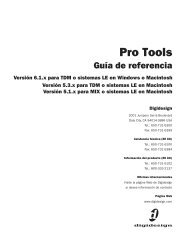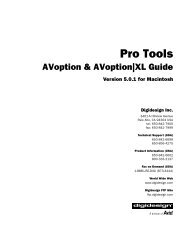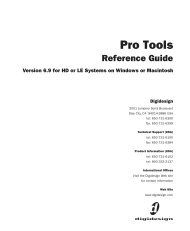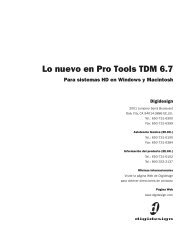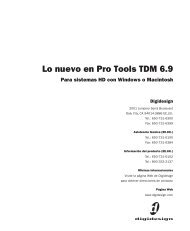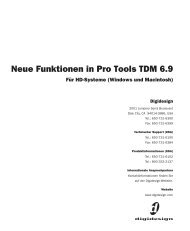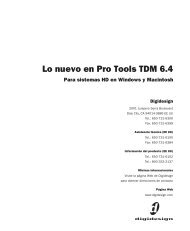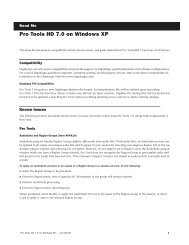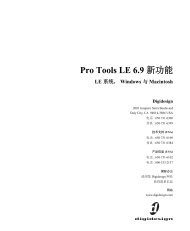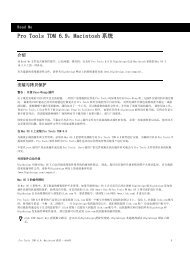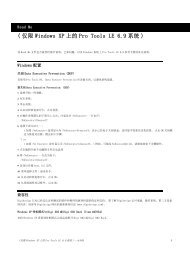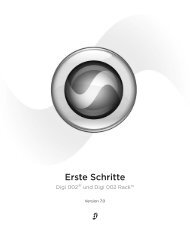5.1 DigiRack Plug-Ins Guide - Digidesign Support Archives
5.1 DigiRack Plug-Ins Guide - Digidesign Support Archives
5.1 DigiRack Plug-Ins Guide - Digidesign Support Archives
Create successful ePaper yourself
Turn your PDF publications into a flip-book with our unique Google optimized e-Paper software.
To edit parameters with a keyboard:<br />
◆ Click the parameter text field that you want to<br />
edit. Type the desired value.<br />
◆ In fields that support values in kilohertz, typing<br />
“k” after a number value will multiply the<br />
value by 1000. (If you want to enter a value of<br />
8000, type “8k”).<br />
◆ To increase a value, press the Up Arrow on<br />
your keyboard. To decrease a value, press the<br />
Down Arrow on your keyboard.<br />
◆ Press Enter on the numeric keyboard after typing<br />
a value to input the value (without leaving<br />
the selected parameter field).<br />
◆ Press Return (Macintosh) or Enter on the alpha<br />
keyboard (Windows) to enter the value and<br />
leave keyboard editing mode.<br />
To move downward through the different parameter<br />
fields, press the Tab key. To move upwards,<br />
press Shift+Tab.<br />
Linking and Unlinking Controls on<br />
Multi-Mono <strong>Plug</strong>-ins<br />
When a multi-mono plug-in is used on a multichannel<br />
track, the controls are normally linked.<br />
Adjusting the Gain parameter on one channel,<br />
for example, will adjust it for all channels.<br />
If necessary, you can unlink plug-in controls on<br />
specific channels of a track and edit them independently.<br />
You can also selectively link the controls<br />
of specific channels.<br />
Master Link button<br />
Link Enable buttons<br />
Channel selector<br />
Channel Selector and Link controls<br />
To unlink controls on a multi-mono plug-in:<br />
■ Deselect the Master Link button.<br />
To access controls for a specific channel:<br />
■ Select the desired channel from the Channel<br />
Selector.<br />
To link the controls of specific channels:<br />
1 Deselect the Master Link button if it is not already<br />
deselected.<br />
2 Click the Link Enable buttons for the channels<br />
whose controls you want to link.<br />
Using a Key Input for Side<br />
Chain Processing<br />
Some plug-ins, such as the Compressor, Limiter,<br />
Gate, and Expander/Gate feature side-chain processing<br />
capabilities. Side-chain processing allows<br />
you to trigger a plug-in from a separate reference<br />
track or external audio source. The source<br />
used for triggering is referred to as the key input.<br />
Key inputs are monophonic.<br />
A typical use for this feature is to control the dynamics<br />
of one audio signal using the dynamics<br />
of another signal (the key input). A kick drum<br />
track, for example, can be used to trigger gating<br />
of a bass track to tighten it up. A rhythm guitar<br />
track can be used to gate a keyboard pad, and so<br />
on.<br />
RTAS plug-ins do not provide side-chain<br />
processing when used on TDM-based systems.<br />
Chapter 2: Working with Real-Time <strong>Plug</strong>-<strong>Ins</strong> 11



